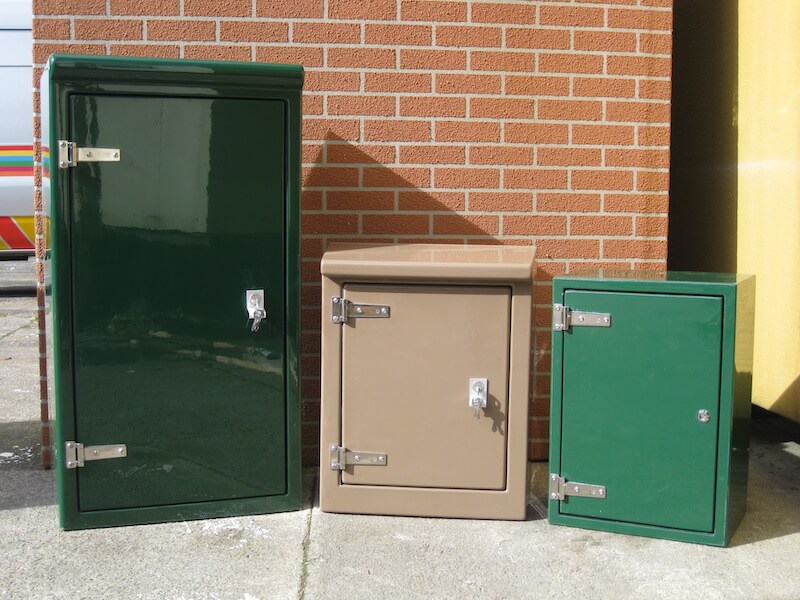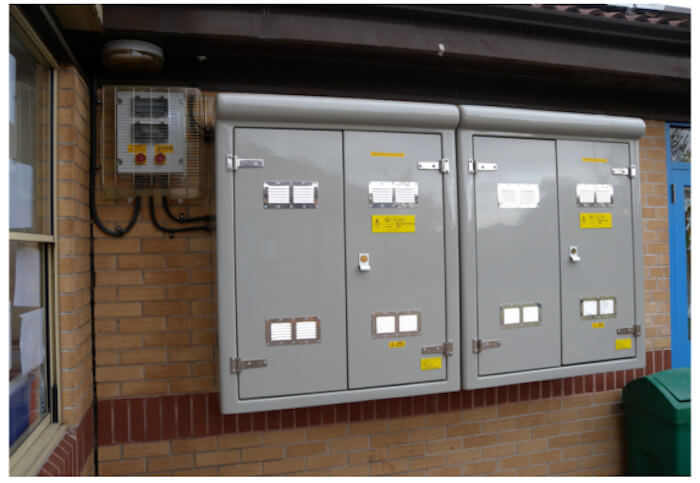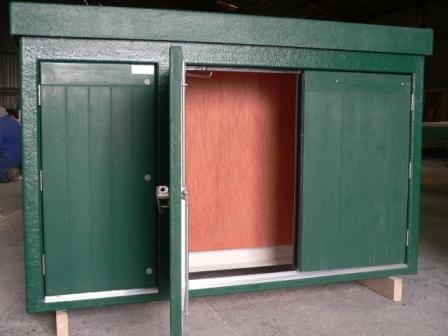The choice of materials stands as an important decision that can significantly influence the success of your GRP kiosk and its longevity. The careful selection of materials goes beyond aesthetics; it directly impacts functionality, durability, and the overall appeal of the kiosk. As businesses and organisations seek to create efficient spaces, understanding the significance of making informed decisions regarding materials becomes a determining factor.
In this article, we delve into kiosk materials, with a specific focus on Glass Reinforced Plastic (GRP) and its comparison with other commonly used materials.
Beyond the surface-level considerations of design, we aim to unravel the crucial aspects of functionality, durability, and aesthetic appeal that must be at the forefront of decision-making when choosing the right material for your kiosk.

Overall Kiosk Market Growth: The broader kiosk market, which includes various types of kiosks beyond just GRP, is projected to grow from USD 28.60 billion in 2023 to USD 51.05 billion by 2028, at a CAGR of 12.29% during the forecast period. This growth is driven by the increasing demand for self-service solutions across various industries. [R]
GRP is a composite material made up of a polymer matrix reinforced with glass fibres. This combination imparts a remarkable strength-to-weight ratio to the material, making it an ideal candidate for various applications, including kiosk construction. The composition of GRP ensures that it inherits the best properties of both the polymer matrix and the reinforcing glass fibres. More can be found on our what are fibreglass enclosures article which provides a detailed breakdown on the composite material and its key benefits.
In the landscape of kiosk construction, a variety of materials are employed, each bringing its own set of characteristics. In this section, we explore some of the most commonly used materials for kiosks—metal, wood, and plastic—shedding light on their distinct qualities and potential considerations.

Metal has long been a stalwart in construction, and its application extends to the creation of kiosks. Noteworthy features include:
Wood evokes a timeless aesthetic and is often chosen for its natural appeal. Key characteristics include:
Plastic, with its diverse range of formulations, has become a popular material in kiosk construction. Considerations include:
When it comes to choosing materials for kiosks, a practical cost analysis is key to ensuring that the selected solution aligns with both immediate budgets and long-term financial goals. Going beyond the upfront costs, a thorough examination involves considering the broader financial picture, including maintenance, repairs, and the potential for replacements.
Let’s take a closer look at the cost analysis of Glass Reinforced Plastic (GRP) kiosks compared to other common materials.
GRP kiosks often offer a cost-effective advantage in terms of initial expenses. The production processes for GRP allow for budget-friendly manufacturing, resulting in a lower initial investment compared to materials like metal or wood. However, it’s important to note that initial costs may also be influenced by factors such as design complexity, size, and customisation needs.
GRP kiosks stand out for their low maintenance requirements. The inherent properties of GRP, such as resistance to corrosion and weathering, mean less need for regular upkeep. Unlike metal structures, GRP kiosks don’t face the risk of rust or corrosion, leading to lower maintenance costs over time. This advantage is particularly noticeable in outdoor settings where exposure to the elements can impact structural integrity.
In comparison, metal kiosks, while sturdy, require consistent maintenance efforts to combat corrosion. Regular inspections, protective coatings, and rust treatments are essential to maintain their durability, contributing to higher long-term maintenance expenses.
Wood, on the other hand, demands careful attention to prevent decay, insect damage, and other weather-related wear. The ongoing need for sealing, treatments, and repairs may result in increased maintenance costs over time.
In terms of repairs, GRP kiosks are often more resilient. The material’s durability minimises the likelihood of structural damage, reducing the frequency and extent of necessary repairs. In contrast, metal structures may need more immediate attention in the event of dents, scratches, or corrosion spots. Wood, being susceptible to decay and insect damage, might require regular repairs to address structural integrity issues.
GRP containers would appear to be the best material to use based on its flexibility, strength, and resilience to adverse weather. So why is it then that other materials are being used in the industry?

The answer lies in the diverse array of industry-specific regulations and standards that govern the use of materials in different contexts. While GRP possesses numerous favourable attributes, certain sectors may have specific compliance requirements that drive the selection of alternative materials to ensure adherence to safety, structural, or environmental regulations unique to their operational landscapes.
Let us look at some examples:
In the construction industry, where kiosks often serve as temporary or semi-permanent structures, GRP materials must meet building codes and regulations. GRP, being non-corrosive and durable, aligns well with safety and structural integrity standards set by construction authorities. Its compliance with fire safety regulations makes it suitable for applications where fire resistance is a crucial requirement.
In the telecommunications industry, where kiosks house equipment such as network cabinets, GRP is a preferred material due to its resistance to environmental factors. Compliance here entails meeting industry standards for electrical safety and electromagnetic interference shielding. GRP’s non-conductive properties contribute to meeting safety regulations in the presence of electronic equipment.
In transportation hubs such as airports or train stations, metal kiosks are prevalent. Metals like stainless steel are chosen for their robustness and resistance to tampering. Compliance in this context involves adherence to security standards set by transportation authorities to ensure that the materials meet safety and anti-terrorism regulations.
In areas with historical significance or heritage zones, wooden kiosks may be favoured for their aesthetic appeal. Compliance here involves adhering to preservation guidelines and architectural standards set by heritage conservation boards. These standards ensure that the use of wood respects the historical character of the surroundings while meeting structural and safety requirements.
Plastic kiosks, known for their portability and versatility, are often used in outdoor events like festivals or markets. Compliance in this context involves meeting health and safety regulations, especially regarding crowd control and accessibility. Additionally, the materials used must be food-grade compliant if the kiosk is involved in food service.
The choice of materials stands as an important decision that can significantly influence the success of your GRP kiosk and its longevity. The careful selection of materials goes beyond aesthetics; it directly impacts functionality, durability, and the overall appeal of the kiosk. As businesses and organisations seek to create efficient spaces, understanding the significance of making informed decisions regarding materials becomes a determining factor.
In this article, we delve into kiosk materials, with a specific focus on Glass Reinforced Plastic (GRP) and its comparison with other commonly used materials.
Beyond the surface-level considerations of design, we aim to unravel the crucial aspects of functionality, durability, and aesthetic appeal that must be at the forefront of decision-making when choosing the right material for your kiosk.

Overall Kiosk Market Growth: The broader kiosk market, which includes various types of kiosks beyond just GRP, is projected to grow from USD 28.60 billion in 2023 to USD 51.05 billion by 2028, at a CAGR of 12.29% during the forecast period. This growth is driven by the increasing demand for self-service solutions across various industries. [R]
GRP is a composite material made up of a polymer matrix reinforced with glass fibres. This combination imparts a remarkable strength-to-weight ratio to the material, making it an ideal candidate for various applications, including kiosk construction. The composition of GRP ensures that it inherits the best properties of both the polymer matrix and the reinforcing glass fibres. More can be found on our what are fibreglass enclosures article which provides a detailed breakdown on the composite material and its key benefits.
In the landscape of kiosk construction, a variety of materials are employed, each bringing its own set of characteristics. In this section, we explore some of the most commonly used materials for kiosks—metal, wood, and plastic—shedding light on their distinct qualities and potential considerations.

Metal has long been a stalwart in construction, and its application extends to the creation of kiosks. Noteworthy features include:
Wood evokes a timeless aesthetic and is often chosen for its natural appeal. Key characteristics include:
Plastic, with its diverse range of formulations, has become a popular material in kiosk construction. Considerations include:
When it comes to choosing materials for kiosks, a practical cost analysis is key to ensuring that the selected solution aligns with both immediate budgets and long-term financial goals. Going beyond the upfront costs, a thorough examination involves considering the broader financial picture, including maintenance, repairs, and the potential for replacements.
Let’s take a closer look at the cost analysis of Glass Reinforced Plastic (GRP) kiosks compared to other common materials.
GRP kiosks often offer a cost-effective advantage in terms of initial expenses. The production processes for GRP allow for budget-friendly manufacturing, resulting in a lower initial investment compared to materials like metal or wood. However, it’s important to note that initial costs may also be influenced by factors such as design complexity, size, and customisation needs.
GRP kiosks stand out for their low maintenance requirements. The inherent properties of GRP, such as resistance to corrosion and weathering, mean less need for regular upkeep. Unlike metal structures, GRP kiosks don’t face the risk of rust or corrosion, leading to lower maintenance costs over time. This advantage is particularly noticeable in outdoor settings where exposure to the elements can impact structural integrity.
In comparison, metal kiosks, while sturdy, require consistent maintenance efforts to combat corrosion. Regular inspections, protective coatings, and rust treatments are essential to maintain their durability, contributing to higher long-term maintenance expenses.
Wood, on the other hand, demands careful attention to prevent decay, insect damage, and other weather-related wear. The ongoing need for sealing, treatments, and repairs may result in increased maintenance costs over time.
In terms of repairs, GRP kiosks are often more resilient. The material’s durability minimises the likelihood of structural damage, reducing the frequency and extent of necessary repairs. In contrast, metal structures may need more immediate attention in the event of dents, scratches, or corrosion spots. Wood, being susceptible to decay and insect damage, might require regular repairs to address structural integrity issues.
GRP containers would appear to be the best material to use based on its flexibility, strength, and resilience to adverse weather. So why is it then that other materials are being used in the industry?

The answer lies in the diverse array of industry-specific regulations and standards that govern the use of materials in different contexts. While GRP possesses numerous favourable attributes, certain sectors may have specific compliance requirements that drive the selection of alternative materials to ensure adherence to safety, structural, or environmental regulations unique to their operational landscapes.
Let us look at some examples:
In the construction industry, where kiosks often serve as temporary or semi-permanent structures, GRP materials must meet building codes and regulations. GRP, being non-corrosive and durable, aligns well with safety and structural integrity standards set by construction authorities. Its compliance with fire safety regulations makes it suitable for applications where fire resistance is a crucial requirement.
In the telecommunications industry, where kiosks house equipment such as network cabinets, GRP is a preferred material due to its resistance to environmental factors. Compliance here entails meeting industry standards for electrical safety and electromagnetic interference shielding. GRP’s non-conductive properties contribute to meeting safety regulations in the presence of electronic equipment.
In transportation hubs such as airports or train stations, metal kiosks are prevalent. Metals like stainless steel are chosen for their robustness and resistance to tampering. Compliance in this context involves adherence to security standards set by transportation authorities to ensure that the materials meet safety and anti-terrorism regulations.
In areas with historical significance or heritage zones, wooden kiosks may be favoured for their aesthetic appeal. Compliance here involves adhering to preservation guidelines and architectural standards set by heritage conservation boards. These standards ensure that the use of wood respects the historical character of the surroundings while meeting structural and safety requirements.
Plastic kiosks, known for their portability and versatility, are often used in outdoor events like festivals or markets. Compliance in this context involves meeting health and safety regulations, especially regarding crowd control and accessibility. Additionally, the materials used must be food-grade compliant if the kiosk is involved in food service.
Adept GRP Enclosures are designed & manufactured with a view to providing the most practical and cost effective solutions to our customers specific needs.
We faithfully comply with all of the requirements of our ISO 9001:2015 Quality Management System.
Address
Unit 4
Heathfield Industrial Estate
Thornhill Road
Cwmgwili Carmarthenshire
SA14 6PT
Get in Touch
Email: sales@adeptgrp.co.uk
Phone – 01269 843355
For sales and accounts, select option 1
For existing orders, select option 2